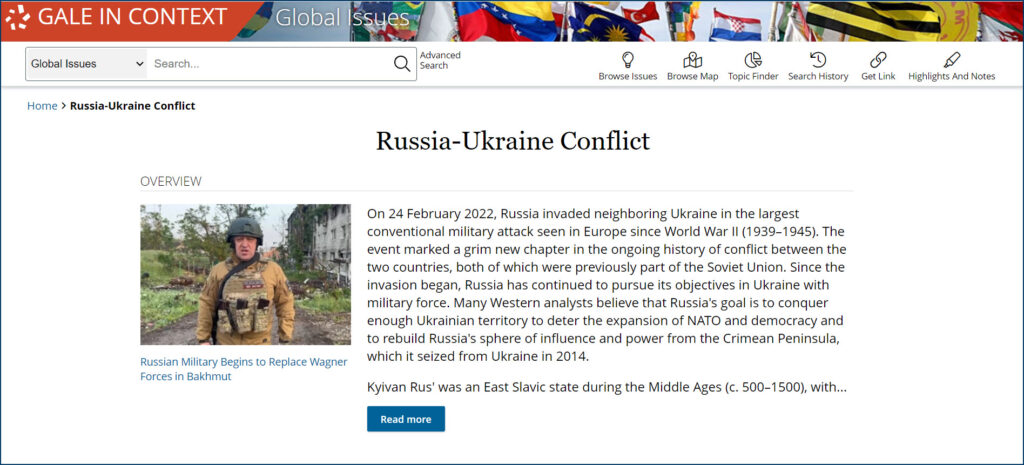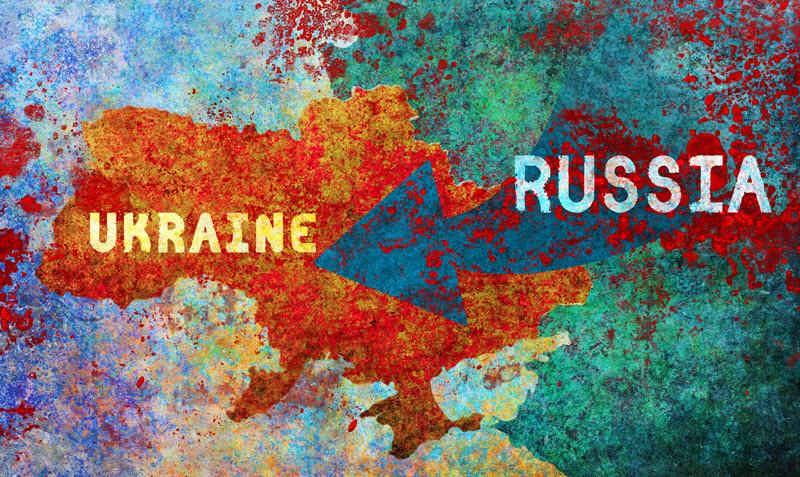| By Gale Staff |
The repercussions of the ongoing conflict between Russia and Ukraine are monumental. While American students face little of the war’s tangible consequences in their daily lives, some have family members impacted by the disruption and violence, while others may feel anxiety from the conflict’s frequent news coverage. Teachers play a vital role in guiding students as they think about and process the conflict’s implications worldwide.
War is a distressing but critical subject for the classroom. Conflict is intimately tied to human history and informs many global relationships today. Studying and understanding war can help us avoid repeating past mistakes. Plus, with the 24-hour news cycle and the internet, your students already engage with the subject in some capacity. Your classroom provides a safe environment to process these challenging conversations and identify real news over biased sources. With this in mind, educators have a valuable opportunity to address and provide context for the Russia-Ukraine Conflict.
Teachers can rely on Gale In Context to help introduce students to this complicated subject through accurate, up-to-date information and vetted resources. Our team of educational experts has curated a Russia-Ukraine Conflict portal specific for high school students. Found within Gale In Context: Global Issues, we crafted this collection with developing researchers in mind. The portal features a comprehensive, organized summary of the Russia-Ukraine conflict alongside thousands of resources for supplemental study, including visual statistics, videos, podcasts, magazines, academic journals, and news articles. Leverage our database to help students understand the lengthy history behind the Russia-Ukraine conflict and why their engagement in world affairs matters.

Develop a Timeline of Events
Oftentimes, a complicated subject is easier to grasp when we break it down into smaller pieces. Timelines illustrate essential connections between people and events and how historical choices inform future consequences. For young American students, the Russian invasion of Ukraine in February 2022 may have felt alarmingly random. But this is hardly the case.
In truth, tensions between the two countries have escalated over decades, and the dispute did not occur in a vacuum. Over the past 30 years, the two nations have engaged in a tug-of-war over Ukrainian sovereignty, NATO membership, and valuable resources.
Using the Russia-Ukraine Conflict portal, consider working as a class to create a timeline of the significant events leading up to and throughout the Russia-Ukraine conflict. This exercise will help your students understand the connections and complexities of the two nations’ ongoing strife.
1991: Tension for current hostilities goes back to the fall of the Soviet Union. Russia and Ukraine were both members of the former communist state, but in December 1991, Ukraine became an independent country. The two nations share significant cultural ties, and many Russians and Russian-speaking Ukrainians remain in the now-independent Ukraine.
1994: In exchange for its significant nuclear stockpile following the Cold War, Ukraine requested certain assurances regarding its independence from Russia. The agreement is called the Budapest Memorandum.
2004: Ukraine held a presidential election between Viktor Yushchenko and Viktor Yanukovych. Yushchenko is a Western-backed figure who advocates for democracy, whereas Yanukovych derived his support from Russia. Yushchenko was mysteriously poisoned in the run-up to the election but survived and Yanukovych became president by default. Pro-democracy Ukrainians wearing Yushchenko’s campaign color, orange, peacefully protested the power grab in an event later named the Orange Revolution. Protesters ultimately forced a re-vote for the fraudulent election, and Yushchenko took office.
2008: Ukraine lobbied to join the NATO alliance. Russian President Vladimir Putin advocated against Ukraine, admitting to then-President George W. Bush that, in his eyes, “Ukraine is not even a country.”

2009: Prime Minister Yulia Tymoshenko of Ukraine negotiated a gas importation deal with Russia to open pipelines to Europe. The agreement was highly controversial as the former prime minister was accused of criminal abuse of power for her role in the deal.
2010: Russian-backed Victor Yanukovych won the presidential election. He raised charges of abuse of power against political opponent Tymoshenko, ultimately leading to her arrest.
2014: President Yanukovych refused to sign a European Union free-trade agreement, consequentially aligning the country closer to Russian influence. In response, a protest movement known as Euromaidan began. Tensions escalated, and on February 20, 2014, military snipers killed dozens of protesters. Yanukovych was forced out of office and fled to Russia. Taking advantage of Ukraine’s instability, Russia disregarded international accords and illegally invaded Crimea, creating a precedent for future aggression.
2019: Beloved comedian Volodymyr Zelensky became president of Ukraine. He sought U.S. aid to end the ongoing Russian occupation of the Crimea region.
2021: Putin issued demands to NATO that the alliance never allow Ukraine to join. The Russian president threatens severe consequences should the organization add Ukraine as a member.
2022: Russia launched a full invasion of Ukraine. The international community broadly condemned the invasion and sent military aid to Ukraine. Russia began a campaign of misinformation to defend its aggression toward its neighboring country.
2023: Countries, especially the United States, pledge significant financial and military assistance to Ukraine. In February, on the one-year anniversary of the invasion, President Biden visited Kyiv to meet with Zelensky. Meanwhile, Putin gathered his supporters, notably China, Iran, North Korea, Hungary, and Belarus. Stay up-to-date on the latest events of the war with your students as the 2nd anniversary of the invasion is quickly approaching in 2024
Learn About Key Figures
Help your students better understand the key figures behind the two countries’ complicated histories with Gale’s Russia-Ukraine Conflict portal. Gale provides in-depth information about each of these characters. Several world leaders significantly contributed to modern-day tensions and uncertainties, from Gorbachev‘s foreign policy to Yanukovych’s rise in power and subsequent flight to Russia. It’s easy to define the current narrative as Zelensky versus Putin, but the cast and their motivations are far more complex. Studying the various leaders provides helpful context for the overall conflict.
Empower Students to Follow Current Global Events
The Russia-Ukraine war is one of modern history’s most significant global conflicts. Europe has not experienced this level of violence since World War II. Major powers are forming new alliances, and the global food and fuel supply chain is in distress and renewed hostilities between Israel and Hamas only add to the global dimensions of this conflict.. The world has never been more connected, which can be overwhelming for many with daily news of attacks and more casualties. With Gale, high school teachers can thoughtfully introduce this critical topic into their classroom discussion in a supportive environment powered by Gale’s comprehensive, vetted, and trusted archives. Even though the conflict is far from American borders, it has a direct impact on our lives and is shaping the world our students will inherit.
With Gale, you can help students become better researchers and scholars by guiding them away from bias and misinformation. Students will learn to think critically about world affairs and develop empathy for those affected by violence. If your institution does not subscribe to Gale, you can contact a local representative and request a Gale In Context: Global Issues trial for your classroom.

